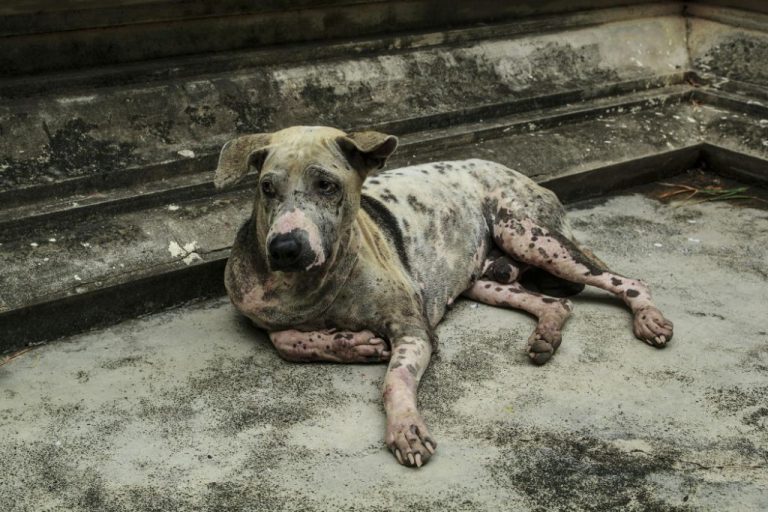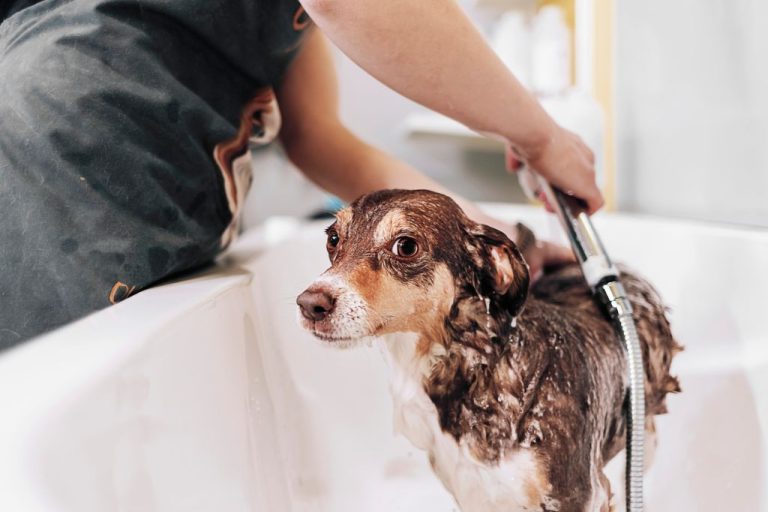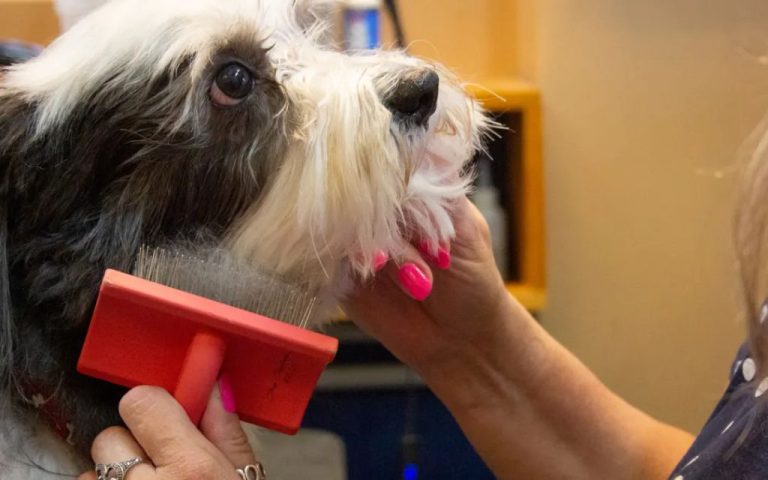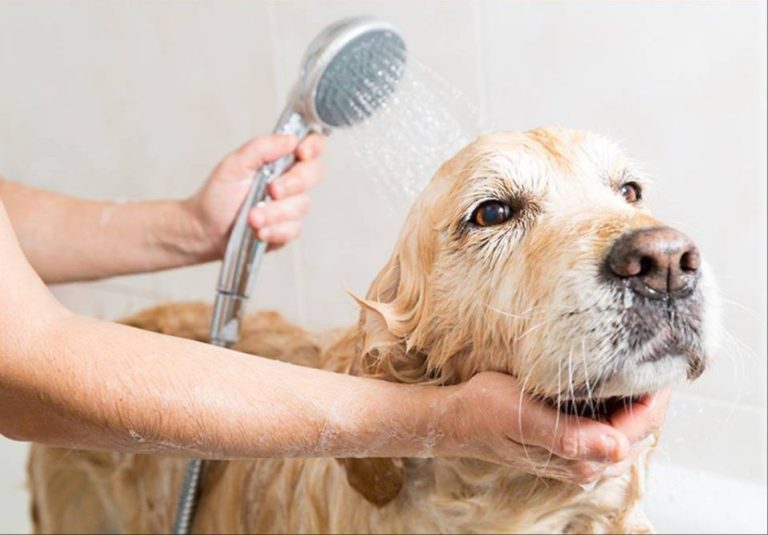Dematting Your Dog’S Hair: Gentle Methods For Tangled Fur

Matted fur occurs when a dog’s hair becomes tangled and wraps around itself, forming tight clumps and knots. This happens as a result of loose undercoat shedding and getting trapped in the top layer of fur. Dead hair, skin cells, and debris can also get caught in the mats, causing them to become larger and tighter over time. Matted fur does not shed properly and pulls on the skin, which can be very uncomfortable and even painful for dogs. Severe matting can restrict blood flow, trap moisture and bacteria against the skin, and lead to sores and infection. Keeping a dog’s coat brushed and detangled is important to prevent mats from forming.
Assess the Severity
The first step is to assess how severe your dog’s matting is. Look over their coat and note where the mats are located and their size. Small mats just starting to form can often be brushed out, while large, tight mats close to the skin will likely need to be cut off. Check the texture – mats that feel dry, brittle and tightly woven will be extremely difficult to remove without cutting the hair. According to urbanhounds.com, “After you’ve finished line brushing, check for mats with a metal comb. Begin at the base of the hair, directly against the skin. If your comb catches, you’ve found a mat.”
Brush Before Bathing
Before bathing your dog, it’s important to brush out as many mats as possible. This helps the shampoo and water fully penetrate the coat. For tangled fur, experts recommend using a high-quality slicker brush made for dogs. Slicker brushes have fine, flexible bristles that can gently work through knots while minimizing pain and breakage.
When brushing, always start at the ends of the fur and slowly work up towards the body. Take your time and don’t force the brush through stubborn tangles, as this can hurt the dog and damage the coat. Try holding the fur above the mat as you gently brush it out. Use short strokes and lift the brush frequently to remove the hair caught in it. Regular brushing can help prevent new mats from forming. According to pet grooming guides, the Maxpower Planet slicker brush is a top choice for detangling severely matted fur.
Bathe with Detangling Shampoo
One of the most effective ways to start detangling mats is by bathing your dog with a high-quality detangling shampoo. These specially formulated shampoos contain ingredients like oatmeal, aloe vera, vitamin E, and jojoba oil that help moisturize, condition, and detangle fur.[1] When using a detangling shampoo, follow these steps:
First, thoroughly wet your dog’s coat and skin with warm water. Make sure the fur is completely soaked before applying shampoo. Then, gently massage a generous amount of detangling shampoo all over your dog’s body. Pay extra attention to matted areas, working the shampoo thoroughly into the knots and tangles.
Let the shampoo sit for 5-10 minutes before rinsing so it has time to penetrate and loosen mats. As you’re rinsing, use your fingers to gently tease apart tangles. Avoid rubbing or scrubbing matted fur too aggressively. Rinse until the water runs clear.
Repeat if needed for heavy mats. The shampoo will lubricate and loosen the hair strands trapped in tangles to make detangling easier. Always follow up with an equally high-quality detangling conditioner as well.
Blow Dry
After bathing your dog, it’s important to thoroughly blow dry their coat to avoid matting. According to Tips and Tricks to Blow Dry your Dog, you should use a blow dryer on a cool setting to avoid burning your dog’s skin. Hold the dryer about 6 inches from your dog and continuously brush through their coat as you dry. Make sure to get down to the undercoat. Run your fingers through your dog’s hair to check for dampness and keep blow drying until the coat is completely dry. Avoid over-drying, as this can damage the coat. Thorough blow drying helps straighten the hair follicles and prevent tangles.
Detangle Small Mats
If your dog has small, minor tangles or mats, you may be able to gently work them out without too much trouble. Start by spraying the matted area with a detangling solution or water to help lubricate the fur. Allow the solution to soak in for 5-10 minutes.
Next, use your fingers to very gently tease apart and loosen the mat, starting from the ends and slowly working up towards the base. Take your time and be extremely gentle, never pulling or yanking. According to veterinarians, gently working mats with your fingers is less likely to pull or damage the skin [1].
You can also use a de-matting brush or comb to gently brush out small tangles, working in sections and again starting from the ends. Always brush the fur following the direction it grows to avoid causing pain. Make sure to stop and assess if your dog shows signs of discomfort.
While minor tangles can often be gently brushed or combed out, never force a mat out if it’s too tight or causing pain. For severe mats, it’s much safer to carefully cut them out.
Carefully Cut Out Large Mats
For mats that are too large and tightly wound for gentle brushing or combing, you may need to carefully cut them out with scissors. Using scissors runs the risk of cutting your dog’s skin if done improperly, so take great care with this method. https://vetericyn.com/blog/how-to-get-mats-out-of-dog-hair-effectively/
Make sure to use rounded tip scissors designed specifically for pet grooming. Go under the mat near the skin, while being incredibly cautious not to actually touch the skin or cut the hair too short. Slowly cut into the mat little by little to break it up before removing large sections.
Cutting mats is time consuming and requires patience. Work on small sections and take breaks to avoid frustrating you or your dog. Stop if your dog gets agitated or it becomes unsafe to continue. Removing a few mats at a time over multiple sessions is better than risking injury by rushing the process.
Prevent Future Mats
The best way to prevent painful mats from forming in your dog’s coat is through regular grooming and brushing. Ideally, you should brush your dog’s coat every day if possible, according to the American Society for the Prevention of Cruelty to Animals. Focus on areas prone to matting, like behind the ears, under the arms, and along the belly and legs.
Use a slicker brush or metal comb all the way down to the skin when brushing. Work in small sections and don’t rush. Pay extra attention to areas around collars or harnesses where fur can snag and mat.
Bathing and properly blow drying your dog can also help prevent mats by removing dirt and loose hair. Ask your groomer to trim longer fur that’s prone to tangling. Keeping your dog’s coat shorter will make regular brushing easier.
Make sure your dog is getting proper nutrition to support a healthy coat. Essential fatty acids found in fish oil supplements or foods like salmon can improve coat health. Discuss diet tips with your veterinarian.
When to See a Groomer
If your dog has large, tight mats, especially in sensitive areas like the ears, tail, and groin, it’s best to have a professional groomer remove them. Trying to cut out mats that are close to the skin can risk cutting or injuring your dog. See a groomer if the mats:
- Are very dense, thick, and tightly attached to the skin
- Cover large areas of your dog’s body
- Are around the ears, tail, legs, or groin area
- Seem to be causing your dog discomfort or irritation
Professional groomers have the proper tools and experience to humanely remove severe mats without hurting your dog. They may need to shave the area rather than trying to detangle it. Leaving tight mats can lead to skin irritation, rashes, infections, and hot spots. According to https://www.therufflifemobile.com/matting-groomer-know, intense knots and tangles in fur means a dog is dealing with severe matting that requires professional help.
Conclusion
Matted dog fur can be difficult and frustrating to deal with. However, using gentle dematting techniques is crucial to protect your dog’s sensitive skin and avoid causing unnecessary pain. Key points to remember are assessing the severity, brushing and bathing first, carefully working out small mats, and knowing when professional help is needed. Removing mats requires patience, but is an important part of providing proper grooming care. Preventing mats in the first place through regular brushing is ideal. With some time and care, you can humanely demat your dog’s fur.





